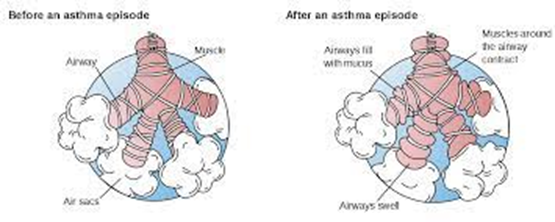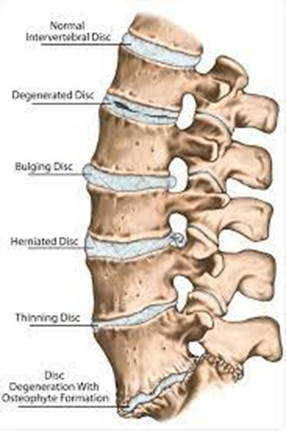A nurse is providing an educational session to colleagues on the unit regarding COPD. Which of the following options would the nurse provide regarding associated risks of COPD?
Weight loss
Poor nutrition
Muscle dysfunction
Increased risk for pneumonia
The Correct Answer is D
Choice A Reason:
Weight loss is inappropriate. Weight loss can occur in individuals with COPD, particularly in advanced stages of the disease. Factors contributing to weight loss may include decreased appetite, increased energy expenditure due to labored breathing, and muscle wasting.
Choice B Reason:
Poor nutrition is inappropriate. Poor nutrition is a significant risk factor in COPD. Individuals with COPD may experience difficulties with eating due to dyspnea, fatigue, and reduced appetite. Malnutrition can lead to muscle weakness, decreased immune function, and worsened respiratory status.
Choice C Reason:
Muscle dysfunction is inappropriate: Muscle dysfunction, particularly skeletal muscle dysfunction, is common in COPD. Reduced physical activity, systemic inflammation, oxidative stress, and metabolic abnormalities contribute to muscle wasting and weakness in individuals with COPD.
Choice D Reason
.Increased risk for pneumonia is incorrect. Individuals with COPD are at an increased risk for respiratory infections, including pneumonia. COPD-related factors such as impaired mucociliary clearance, airway inflammation, and reduced lung function predispose patients to respiratory infections.
Nursing Test Bank
Naxlex Comprehensive Predictor Exams
Related Questions
Correct Answer is C
Explanation
Choice A Reason:
Decreased mucus production contributes to airway constriction: This statement is incorrect. Bronchospasm does not decrease mucus production; instead, it primarily affects the smooth muscles surrounding the bronchioles, leading to their constriction and narrowing of the airways. Increased mucus production, often accompanied by inflammation, can contribute to airway obstruction in conditions like asthma.
Choice B Reason:
Inflammation is reduced due to airway diameter: This statement is incorrect. Bronchospasm typically occurs in the setting of inflammation in conditions such as asthma. Constriction of the airways during bronchospasm exacerbates the inflammation and can further narrow the airways, leading to symptoms such as wheezing and dyspnea.
Choice C Reason:
Bronchospasm occurs when there is inflammation, edema, and excess mucus: This statement is partially correct. Bronchospasm often occurs in the presence of inflammation, edema, and excess mucus production, as seen in conditions like asthma. These factors contribute to airway hyperresponsiveness, leading to bronchospasm and airway narrowing.
Choice D Reason:
Airway obstruction occurs due to thinning mucus: This statement is incorrect. Airway obstruction in conditions like asthma is primarily due to bronchospasm, inflammation, and excessive mucus production, rather than thinning mucus. Thinning of mucus would not typically contribute to airway obstruction.

Correct Answer is C
Explanation
Choice A Reason:
Paralytic ileus is incorrect. Paralytic ileus is a condition characterized by obstruction of the intestines due to paralysis of the intestinal muscles, resulting in symptoms such as abdominal pain, bloating, and constipation. Paralytic ileus is not typically associated with cauda equina syndrome, which primarily affects the nerves in the lower back and lower extremities.
Choice B Reason:
Blood pressure 80/48 mm Hg is incorrect. While cauda equina syndrome can cause neurological symptoms such as lower extremity weakness, numbness, and bowel or bladder dysfunction, it is not typically associated with alterations in blood pressure. Blood pressure changes may occur in response to pain or other systemic factors, but they are not specific to cauda equina syndrome.
Choice C Reason:
Weakness in one or both legs is correct. Yes, weakness in one or both legs is a characteristic finding of cauda equina syndrome. Compression of the nerve roots in the lower spinal cord can lead to motor deficits, including weakness, difficulty walking, and loss of reflexes in the lower extremities.
Choice D Reason:
Potassium 3.2 mEq/L is incorrect. Serum potassium levels are not typically associated with cauda equina syndrome. Abnormal potassium levels may be indicative of electrolyte imbalances, which can occur in various medical conditions but are not specific to cauda equina syndrome.

Whether you are a student looking to ace your exams or a practicing nurse seeking to enhance your expertise , our nursing education contents will empower you with the confidence and competence to make a difference in the lives of patients and become a respected leader in the healthcare field.
Visit Naxlex, invest in your future and unlock endless possibilities with our unparalleled nursing education contents today
Report Wrong Answer on the Current Question
Do you disagree with the answer? If yes, what is your expected answer? Explain.
Kindly be descriptive with the issue you are facing.
